Characteristics and Cause Analysis of the 1954 Yangtze Precipitation Anomalies
Abstract
1. Introduction
2. Meteorological Data
3. Characteristics of the 1954 Precipitation Anomalies
3.1. Characteristics of the Unusual Rainfall over the Yangtze River Valley
3.2. Characteristics of Precipitation Anomalies in Wuhan
4. Causes of the Precipitation Anomalies
4.1. The 1953–1954 El Niño–Southern Oscillation
4.2. SSTAs of the Sea of Okhotsk
5. Precipitation Anomaly Causal Model
6. Conclusions
Supplementary Materials
Author Contributions
Funding
Institutional Review Board Statement
Informed Consent Statement
Data Availability Statement
Acknowledgments
Conflicts of Interest
References
- Xiaoxia, Z.; Yihui, D.; Panxing, W. Moisture Transpotr in Asian Summer Monsoon Region and its Relationship with Summer Precipitation in China. Acta Meteorol. Sin. 2008, 66, 59–70. (In Chinese) [Google Scholar]
- Jena, P.P.; Chatterjee, C.; Pradhan, G.; Mishra, A. Are recent frequent high floods in Mahanadi basin in eastern India due to increase in extreme rainfalls? J. Hydrol. 2014, 517, 847–862. [Google Scholar] [CrossRef]
- Wu, C.; Huang, G. Changes in heavy precipitation and floods in the upstream of the Beijiang River basin, South China. Int. J. Climatol. 2015, 35, 2978–2992. [Google Scholar] [CrossRef]
- Houze, R.A.; Rasmussen, K.L.; Medina, S.; Brodzik, S.R.; Romatschke, U. Anomalous atmospheric events leading to the summer 2010 floods in Pakistan. Bull. Am. Meteorol. Soc. 2011, 92, 291–298. [Google Scholar] [CrossRef]
- Khaing, Z.M.; Zhang, K.; Sawano, H.; Shrestha, B.B.; Sayama, T.; Nakamura, K. Flood hazard mapping and assessment in data-scarce Nyaungdon area, Myanmar. PLoS ONE 2019, 14, e0224558. [Google Scholar] [CrossRef] [PubMed]
- Li, X.; Zhang, K.; Gu, P.; Feng, H.; Yin, Y.; Chen, W.; Cheng, B. Changes in precipitation extremes in the Yangtze River Basin during 1960–2019 and the association with global warming, ENSO, and local effects. Sci. Total Environ. 2021, 760, 144244. [Google Scholar] [CrossRef] [PubMed]
- Lü, M.; Wu, S.J.; Chen, J.; Chen, C.; Wen, Z.; Huang, Y. Changes in extreme precipitation in the Yangtze River basin and its association with global mean temperature and ENSO. Int. J. Climatol. 2018, 38, 1989–2005. [Google Scholar] [CrossRef]
- Ji, Z.; Shan, H. Threshold diagnosis and hazard dangerousness evaluation for the disaster of drought-flood abrupt alternation in the middle and lower reaches of the Yangtze River. Resour. Environ. Yangtze Basin 2015, 24, 1713–1717. (In Chinese) [Google Scholar]
- Wu, Z.; Li, J.; He, J.; Jiang, Z. Large-scale atmospheric singularities and summer long-cycle droughts-floods abrupt alternation in the middle and lower reaches of the Yangtze River. Chin. Sci. Bull. 2006, 51, 2027–2034. (In Chinese) [Google Scholar] [CrossRef]
- Yang, S.; Wu, B.; Zhang, R.; Zhou, S. Relationship between an abrupt drought-flood transition over mid-low reaches of the Yangtze River in 2011 and the intraseasonal oscillation over mid-high latitudes of East Asia. Acta Meteorol. Sin. 2013, 27, 129–143. [Google Scholar] [CrossRef]
- Ronghui, H.; Yifang, W. The Influence of ENSO on the Summer Climate Change in China and Its Mechanism. Adv. Atmos. Sci. 1989, 6, 21–32. [Google Scholar] [CrossRef]
- Wang, B.; Wu, R.; Fu, X. Pacific–East Asian Teleconnection: How Does ENSO Affect East Asian Climate? J. Clim. 2000, 13, 1517–1536. [Google Scholar] [CrossRef]
- Zhang, R.; Sumi, A.; Kimoto, M. A Diagnostic Study of the Impact of El Nino on the Precipitation in China. Adv. Atmos. Sci. 1999, 16, 229–241. [Google Scholar] [CrossRef]
- Huang, R.; Sun, F. Impacts of the tropical western Pacific on the East Asian summer monsoon. J. Meteorol. Soc. Jpn. Ser. II 1992, 70, 243–256. [Google Scholar] [CrossRef]
- Zhang, R.; Sumi, A.; Kimoto, M. Impact of El Niño on the East Asian monsoon a diagnostic study of the’86/87 and’91/92 events. J. Meteorol. Soc. Jpn. Ser. II 1996, 74, 49–62. [Google Scholar] [CrossRef]
- Lau, K.; Wu, H. Principal modes of rainfall–SST variability of the Asian summer monsoon: A reassessment of the monsoon–ENSO relationship. J. Clim. 2001, 14, 2880–2895. [Google Scholar] [CrossRef]
- Qingcun, Z.; Zhaohui, L.; Guangqing, Z. Dynamical extraseasonal climate prediction system IAP DCP-II. Chin. J. Atmos. Sci.-Chin. Ed. 2003, 27, 289–303. (In Chinese) [Google Scholar]
- Ding, Y.H.; Li, Q.Q.; Li, W.J.; Luo, Y.; Zhang, P.Q.; Zhang, Z.Q.; Shi, X.L.; Liu, Y.M.; Wang, L. Advance in Seasonal Dynamical Prediction Operation in China. Acta Meteorol. Sin. 2004, 62, 598–612. (In Chinese) [Google Scholar]
- Xue, F.; Liu, C. The influence of moderate ENSO on summer rainfall in eastern China and its comparison with strong ENSO. Chin. Sci. Bull. 2008, 53, 791–800. [Google Scholar] [CrossRef]
- Feng, L.H.; Chen, L.R. Three Large Floods along the Yangtze River in the 20th Century. J. Nat. Disasters 2001, 10, 8–11. (In Chinese) [Google Scholar]
- Lihua, F.; Xiong, C. Superposition Function of Physical Factor in Super-Huge Flood along the Changjiang River in 1954. Sci. Geogr. Sin. 2004, 24, 753–756. (In Chinese) [Google Scholar]
- Hanyao, C. Circulation Characteristics During the Flood in Yangtze and Hwai-ho Valleys 1954. Acta Meteorol. Sin. 1957, 28, 3–14. (In Chinese) [Google Scholar]
- Jiong, L. Sea Ice and Climate. Acta Geogr. Sin. 1954, 20, 83–94. (In Chinese) [Google Scholar]
- Shuyi, C.; Yuean, L. Compared Analysis of Large-scale Circulation Characteristics in Summer between 1998 and 1954. Meteorol. Mon. 2000, 26, 38–42. (In Chinese) [Google Scholar]
- Administration, C.M. Daily Data Set of Surface Climate Data in China (V3.0); Institute of Tibetan Plateau Research: Beijing, China, 2012. [Google Scholar]
- Huang, B.; Thorne, P.W.; Banzon, V.F.; Boyer, T.; Chepurin, G.; Lawrimore, J.H.; Menne, M.J.; Smith, T.M.; Vose, R.S.; Zhang, H.M. NOAA Extended Reconstructed Sea Surface Temperature (ERSST), Version 5. 2020-9; NOAA National Centers for Environmental Information: Boston, MA, USA, 2017. [Google Scholar]
- Kalnay, E.; Kanamitsu, M.; Kistler, R.; Collins, W.; Deaven, D.; Gandin, L. The NCEP/NCAR 40-Year Reanalysis Project: March, 1996. Bull. Am. Meteorol. Soc. 1994, 77, 437–471. [Google Scholar] [CrossRef]
- Yun, S.; Licheng, L. Catastrophic Flood in the Yangtze River Valley in 1954. Meteorol. Knowl. 2004, 3, 11–15. (In Chinese) [Google Scholar]
- Zhengfu, X. Retrospect of Flood Control in the Yangtze River 1954 and Prospect. China Flood Drought Manag. 2004, 3, 23–31. (In Chinese) [Google Scholar]
- Bjerknes, J. Atmospheric teleconnections from the equatorial Pacific. Mon. Weather Rev. 1969, 97, 163–172. [Google Scholar] [CrossRef]
- Tong, J.; Qiang, Z.; Deming, Z.; Yijin, W. Yangtze floods and droughts (China) and teleconnections with ENSO activities (1470–2003). Quat. Int. 2006, 144, 29–37. [Google Scholar] [CrossRef]
- Zhang, Q.; Xu, C.Y.; Jiang, T.; Wu, Y. Possible influence of ENSO on annual maximum streamflow of the Yangtze River, China. J. Hydrol. 2007, 333, 265–274. [Google Scholar] [CrossRef]
- Zhang, W.; Jin, F.F.; Stuecker, M.F.; Wittenberg, A.T.; Timmermann, A.; Ren, H.L.; Kug, J.S.; Cai, W.; Cane, M. Unraveling El Niño’s impact on the East Asian monsoon and Yangtze River summer flooding. Geophys. Res. Lett. 2016, 43, 11375–11382. [Google Scholar] [CrossRef]
- Administration, C.M. QX/T 370—2017 Identification Method for El Niño/La Niña Events [S]; Meteorological Press: Beijing, China, 2017. [Google Scholar]
- Cai, W.; Wang, G.; Dewitte, B.; Wu, L.; Santoso, A.; Takahashi, K.; Yang, Y.; Carréric, A.; McPhaden, M.J. Increased variability of eastern Pacific El Niño under greenhouse warming. Nature 2018, 564, 201–206. [Google Scholar] [CrossRef] [PubMed]
- Nakamura, H.; Fukamachi, T. Evolution and dynamics of summertime blocking over the Far East and the associated surface Okhotsk high. Q. J. R. Meteorol. Soc. 2004, 130, 1213–1233. [Google Scholar] [CrossRef]
- Dong, W.; Yafei, W.; Min, D. Effects of sea surface temperature anomalies off the east coast of Japan on development of the Okhotsk High. Acta Meteorol. Sin. 2007, 21, 234. [Google Scholar]
- Wang, Y. Effects of blocking anticyclones in Eurasia in the rainy season (Meiyu/Baiu season). J. Meteorol. Soc. Jpn. Ser. II 1992, 70, 929–951. [Google Scholar] [CrossRef][Green Version]
- Yafei, W.; Yasushi, F.; Kuranoshin, K. A teleconnection pattern related with the development of the Okhotsk high and the northward progress of the subtropical high in East Asian summer. Adv. Atmos. Sci. 2003, 20, 237–244. [Google Scholar] [CrossRef]
- Chan, J.C.; Zhou, W. PDO, ENSO and the early summer monsoon rainfall over south China. Geophys. Res. Lett. 2005, 32. [Google Scholar] [CrossRef]
- Mason, S.J.; Goddard, L.; Graham, N.E.; Yulaeva, E.; Sun, L.; Arkin, P.A. The IRI seasonal climate prediction system and the 1997/98 El Niño event. Bull. Am. Meteorol. Soc. 1999, 80, 1853–1874. [Google Scholar] [CrossRef]
- Alves, O.; Balmaseda, M.A.; Anderson, D.; Stockdale, T. Sensitivity of dynamical seasonal forecasts to ocean initial conditions. Q. J. R. Meteorol. Soc. J. Atmos. Sci. Appl. Meteorol. Phys. Oceanogr. 2004, 130, 647–667. [Google Scholar] [CrossRef]
- Yu, F.; Chen, Z.; Ren, X.; Yang, G. Analysis of historical floods on the Yangtze River, China: Characteristics and explanations. Geomorphology 2009, 113, 210–216. [Google Scholar] [CrossRef]
- Tao, S.Y.; Zhang, Q.Y.; Zhang, S.L. The Great Floods in the Changjiang River Valley in 1998. Clim. Environ. Res. 1998, 3, 290–299. (In Chinese) [Google Scholar]
- Chen, G.; Li, W.; Yuan, Z.; Wen, Z. Evolution mechanisms of the intraseasonal oscillation associated with the Yangtze River Basin flood in 1998. Sci. China Ser. D Earth Sci.-Engl. Ed. 2005, 48, 957. [Google Scholar] [CrossRef]
- Shuanglin, L.; Liren, J.; Wantao, L.; Yunqi, N. The maintenance of the blocking over the Ural Mountains during the second Meiyu period in the summer of 1998. Adv. Atmos. Sci. 2001, 18, 87–105. [Google Scholar] [CrossRef]
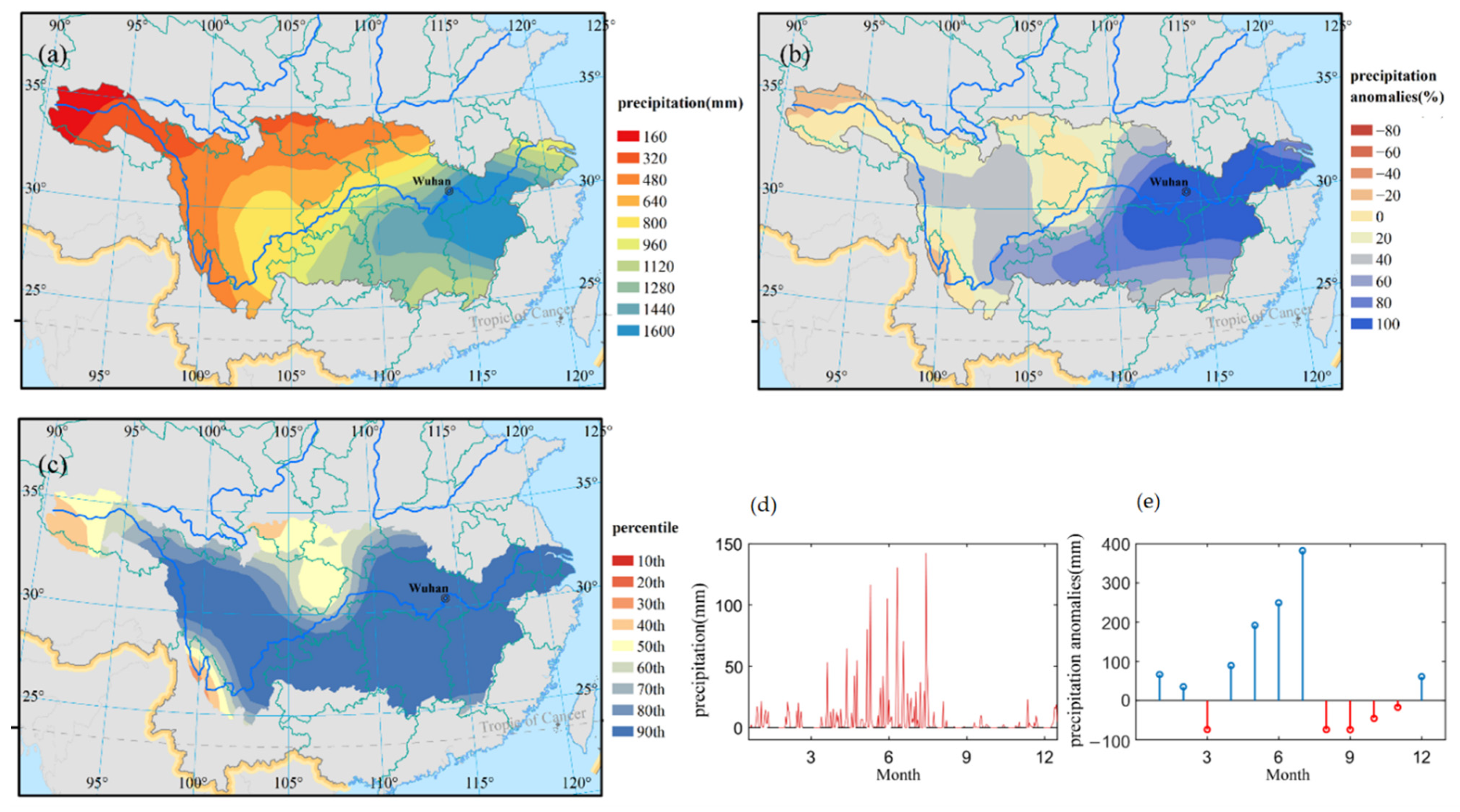
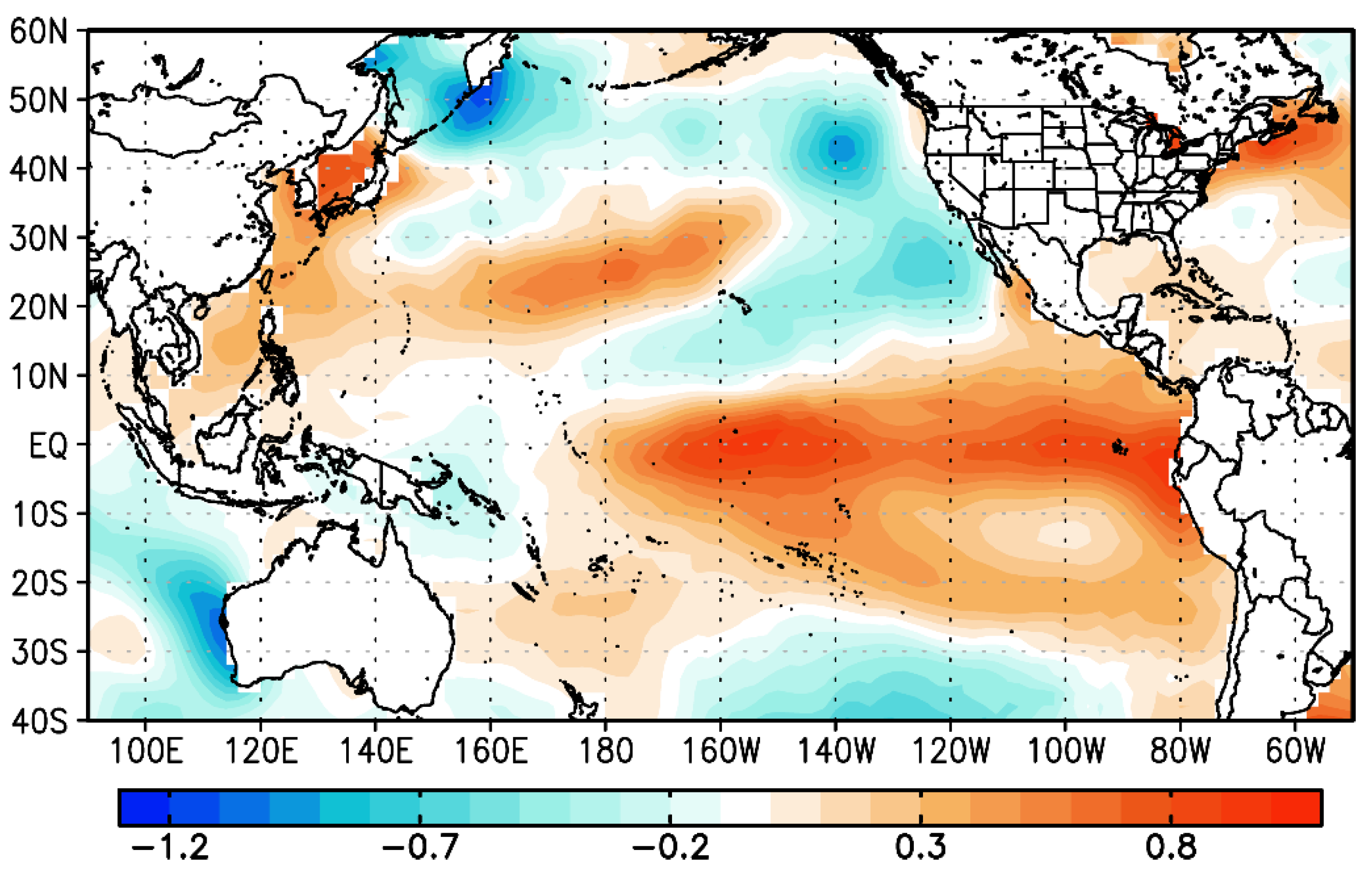
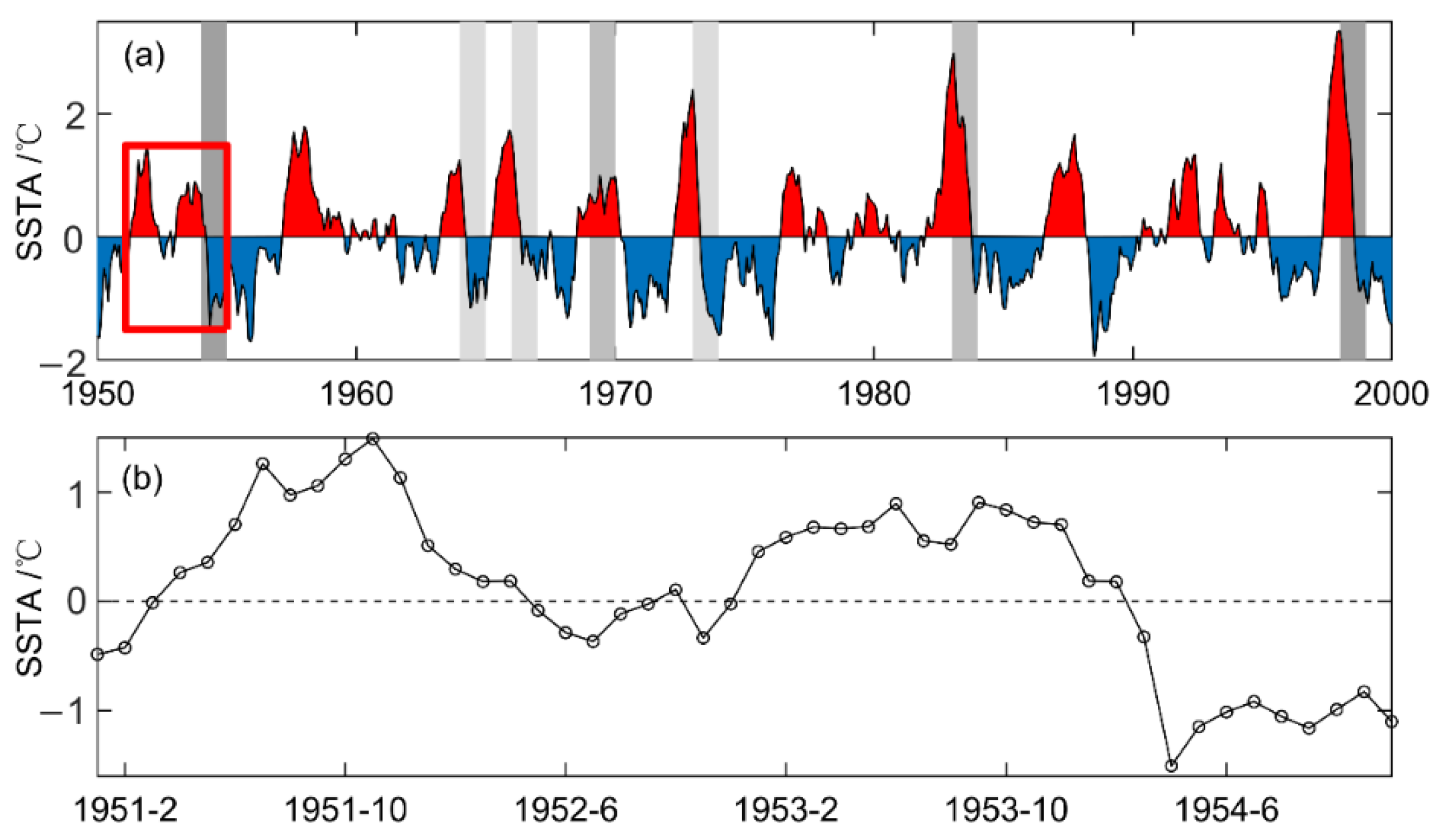


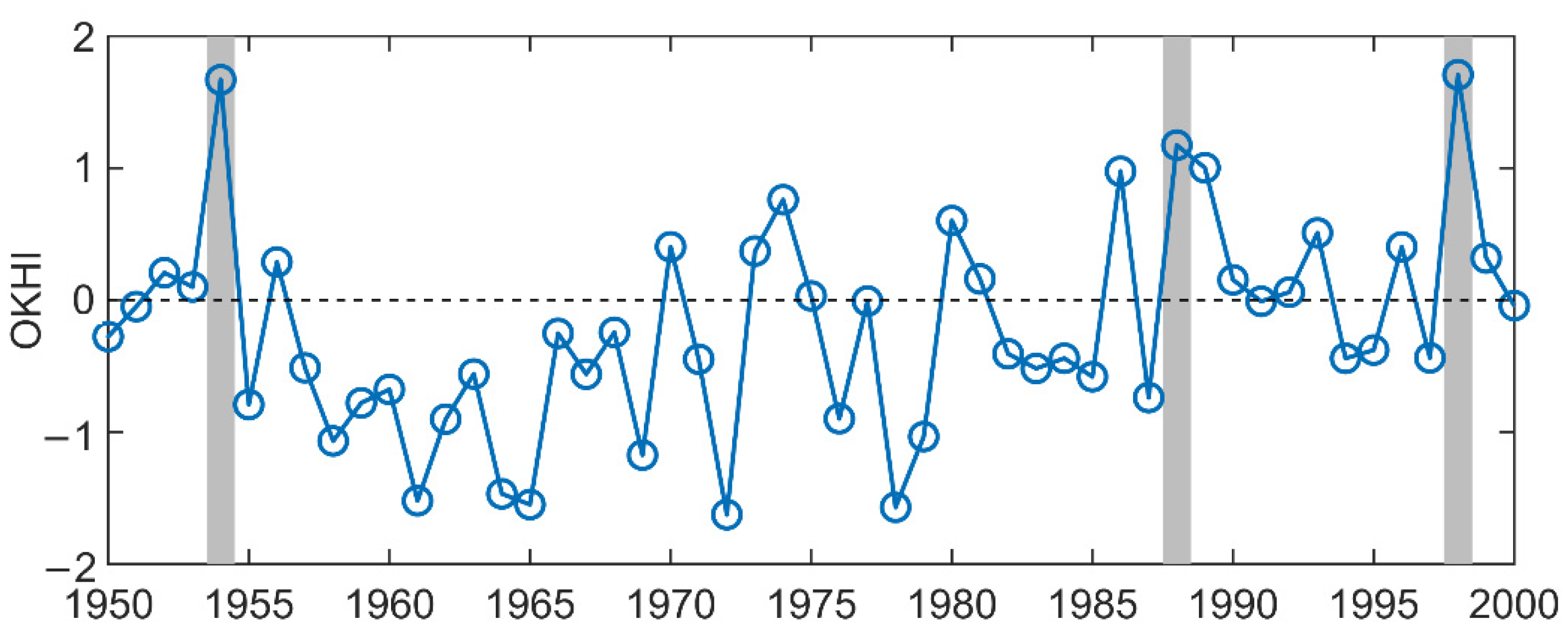
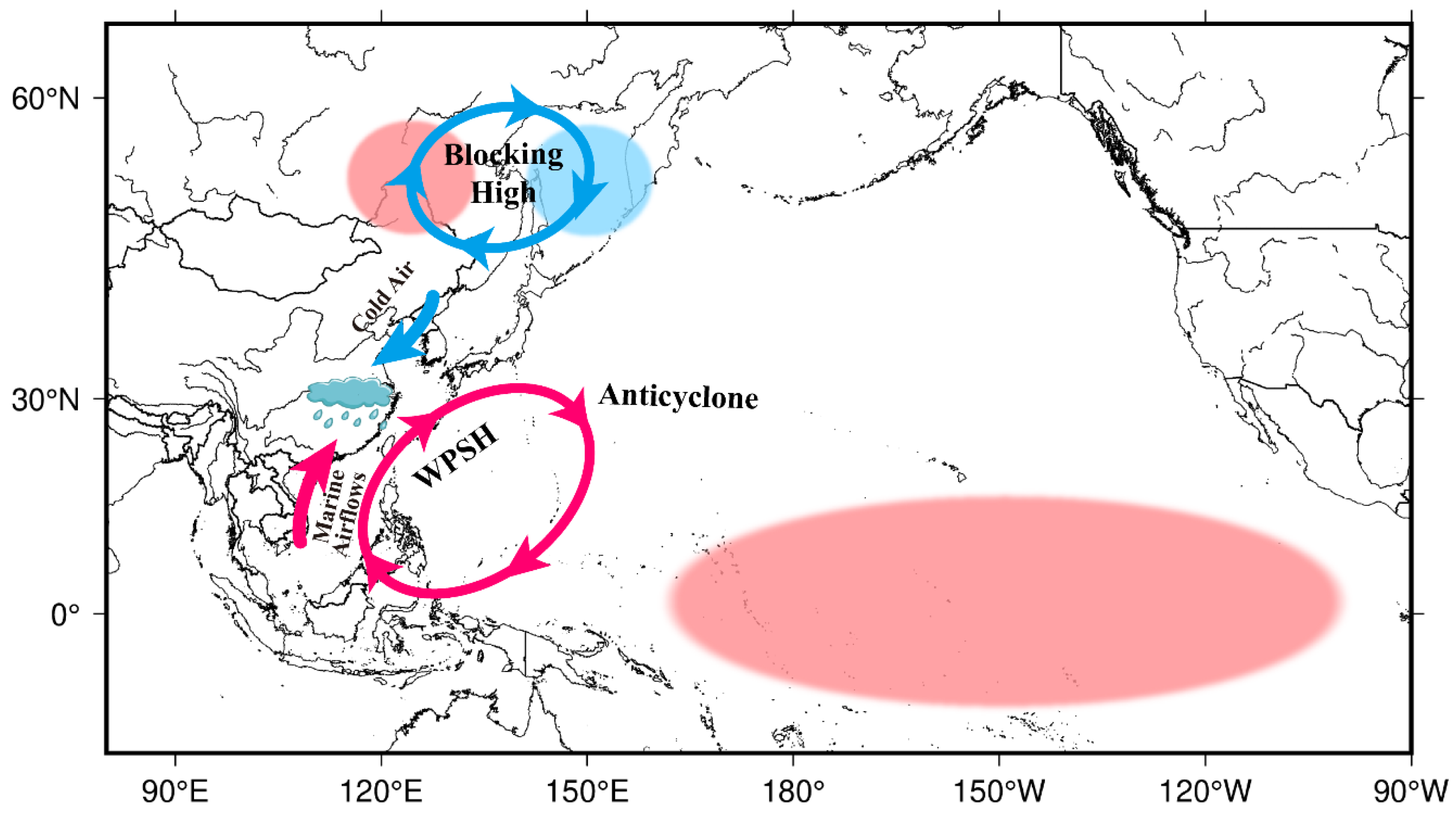
Publisher’s Note: MDPI stays neutral with regard to jurisdictional claims in published maps and institutional affiliations. |
© 2022 by the authors. Licensee MDPI, Basel, Switzerland. This article is an open access article distributed under the terms and conditions of the Creative Commons Attribution (CC BY) license (https://creativecommons.org/licenses/by/4.0/).
Share and Cite
Cai, J.; Zhang, S.; Zhang, Y.; Li, M.; Wei, Y.; Xie, P. Characteristics and Cause Analysis of the 1954 Yangtze Precipitation Anomalies. Remote Sens. 2022, 14, 555. https://doi.org/10.3390/rs14030555
Cai J, Zhang S, Zhang Y, Li M, Wei Y, Xie P. Characteristics and Cause Analysis of the 1954 Yangtze Precipitation Anomalies. Remote Sensing. 2022; 14(3):555. https://doi.org/10.3390/rs14030555
Chicago/Turabian StyleCai, Jianfeng, Shuangxi Zhang, Yu Zhang, Mengkui Li, Yu Wei, and Ping Xie. 2022. "Characteristics and Cause Analysis of the 1954 Yangtze Precipitation Anomalies" Remote Sensing 14, no. 3: 555. https://doi.org/10.3390/rs14030555
APA StyleCai, J., Zhang, S., Zhang, Y., Li, M., Wei, Y., & Xie, P. (2022). Characteristics and Cause Analysis of the 1954 Yangtze Precipitation Anomalies. Remote Sensing, 14(3), 555. https://doi.org/10.3390/rs14030555





